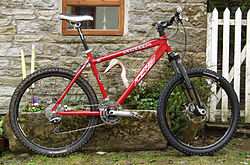Mountain bike
The mountain bike or mountain bike (in English, mountain bike, MTB) or all-terrain bicycle (MTB) is a type of bicycle designed for trips through the mountains or countryside. In some countries they call it a mountain bike, as it is known in Venezuela, the Dominican Republic and other Latin American countries.
The full-suspension bicycle represents the most important advance in cycling in the XX century; since it provides cyclists with the possibility of reaching places that were once considered inaccessible to said vehicle. improving maneuverability and control on uneven terrain. Through it, new forms of cycling have appeared, bringing it closer to the field of extreme sports.
History
In the late 1970s and early 1980s, "bike beach" frames were the basis for the newly developed mountain bike.
In the mid-1970s, a group of bikers in Marin County, California began racing bikes down the downhill Mount Tamalpais firebreaks. A race they called a "repack" because the ride was so grueling that riders had to repack their coaster brakes with grease after each race.
The downhill terrain was rocky and the sheer mountain helped the runners reach high speeds, where they would jump and crash into rocks and mud. This mistreatment caused race bikes to break, so racers sought a more durable and economical alternative. They soon discovered the old jalopies (which they called Klunker), with 26 x 2.125 balloon tires that could be had for $5 at a garage sale and could take some serious punishment. Riders parted ways with these relics, ditching the heavy fenders and trim, as well as retrofitting the bike's brakes and other performance-enhancing gizmos. One cyclist, Gary Fisher, added gears to his old Schwinn Excelsior bike, which allowed him to travel up the mountain as well as down it. Around the same time, another racer, Joe Breeze, began tinkering with his own Schwinn Excelsior, making it more suitable for the repack ride. It is worth mentioning that soon, both began building and selling custom mountain bikes to other enthusiasts; launching a phenomenon throughout the cycling world.
In 1981, Californian Mike Sinyard, founder of the Specialized brand, introduced the Stumpjumper, which was the first mass-produced mountain bike. The Stumpjumper was similar to purpose built mountain bikes, but at $750 (half the price).
Features
It is characterized by components (frame, wheels, gear systems, etc.) that are more resistant to the impacts of the ground and by being provided, in many cases, with a suspension system that can be simple (only suspension on the front fork, called "rigid") or double (front fork with rear shock absorber, called "double"), in addition to single-arm bicycles (which only have one in front, removing one of the two in front to reduce weight). Likewise, the tires are thicker and with studs to better absorb irregularities in the terrain, and thus obtain better traction. Finally, the diameter of its wheels can vary from 24 to 29 inches, with 26 inches being the most used size since its inception, as well as being the easiest to find. Recently the + (plus) formats have been introduced in terms of wheel diameter, such as 27.5+ and 29+. This plus format consists of the use of covers with a balloon slightly larger than the traditional ones, thus achieving greater absorption of irregularities in the terrain.
In the beginnings of this modality, the bicycle frames were made of steel. Currently, for the manufacture of the mountain bike frame, various materials are used, the most common being aluminum, which offers a lightweight frame at a contained price. In the highest range of bicycles, there are frames made of carbon fiber; This is a type of bicycle designed for trips in the mountains or in the fields.
Designs
Mountain bikes can be classified into four categories, based on suspension:
- Completely rigid: a box with a stiff fork and rear, no suspension.
- Rigid with front suspension: hard trail (in English), front suspension of small-travel fork and rigid rear frame.
- Double suspension without pivot: soft trail (in English), a painting with a small route of the rear suspension, which is activated by the bending of the frame type triangle tilting instead of pivots, and front suspension of intermediate route.
- Double or total suspension: full suspension (in English), double fork front suspension from 140 to 203 mm and rear suspension with rear shock absorber commonly of 240 mm for greater comfort and effectiveness, with a link that allows the rear wheel to move on pivots.
Applications
Each of the specialties has given rise to different types of bicycles. Thus, in rallies, bicycles are usually used without rear suspension, with front suspension with little travel and very light (in many cases below 10 kg). At the other extreme, downhill bikes use heavily reinforced and heavy frames, long travel front and rear suspension systems, thick and heavy wheels, etc. Which gives rise to bikes that are around 20 kg.
It is also important to note that mountain biking has experienced a great boom. You no longer only think about the competition: now there are a large number of mtb clubs in most cities where routes are prepared with more people and experiences can be shared and, in this way, make new friendships around this sport.
Within each specialty it is possible to introduce variations in the bicycles that make it more spectacular or difficult. These are the most important variations:
Free riding or Freeride (FR)
It is characterized by using bicycles that place less emphasis on weight and more on suspension travel, without being as robust, heavy, or with travel as (competitive) downhill bikes. They are small, light and very resistant bicycles, specially built for jump parks, where the driver must be very experienced and agile. These bikes allow uphill pedaling, however they are not built for long rides.
Single-speed (SS)
They are mountain bikes with only a fixed gear ratio. The gear ratio chosen depends on the terrain to be ridden, the rider's strength and dexterity, as well as the size of the bike (a bike with 29' wheels often requires different gearing than a bike with standard 29' wheels). 26 inches in diameter). Single speed bikes are generally fully rigid with a steel frame. These bikes are typically ridden by very physically fit individuals on "light to moderate" terrain.
Trail
Bikes with wide travel (120 mm to 150 mm) are used in the suspensions, to be able to make descents safely, but keeping the bikes with low weights and designs that allow easy pedaling, especially on slopes.
Downhill
It is characterized by using heavy and much more resistant bicycles, with even wider travel from 200 mm to 215 mm than traditional mountain bikes; due to its steep descents, full of rocks and obstacles, such as tree roots and large ramps. Departures will take place at intervals, often ordered from slow to fast. Courses usually take two to five minutes to complete the circulation and winning margins are usually less than a second. Riders are programmed with equipment similar to that used in downhill skiing.
Cross Country (XC)
It is the most popular and widespread modality because it usually serves as an initiation in this sport. It is practiced on field, mountain or mountain terrain, normally with rigid bikes that only have 100 mm or 110 mm front fork suspension.
Tools
The mountain or all-terrain bicycle is designed for tours in natural (field) territories and, due to the difficulty of finding a workshop on the road, it is important that the cyclist has a basic toolkit, which consists of in the following (see photos):
1. Adjustable Wrench
2. Spatulas to remove covers
3. Case to repair punctures in tubes
4. Spoke wrench
5. 8, 9 and 10 mm ratchet
6. Flat and star screwdriver (Phillips)
7. 4, 5 and 6 mm Allen keys
8. Chain Breaker
Other essential accessories:
9. Quick assembly chain link
10. Chain lubricant
11. Air chamber
12. air pump
13. Torx keys (in case of using a brake disc on 6-bolt models)
“Multi-tools” are sold on the market, which, like a Swiss Army knife, include various tools with reduced weight and space.
Contenido relacionado
International Cycling Union
Tour de France 2004
World athletics championship










